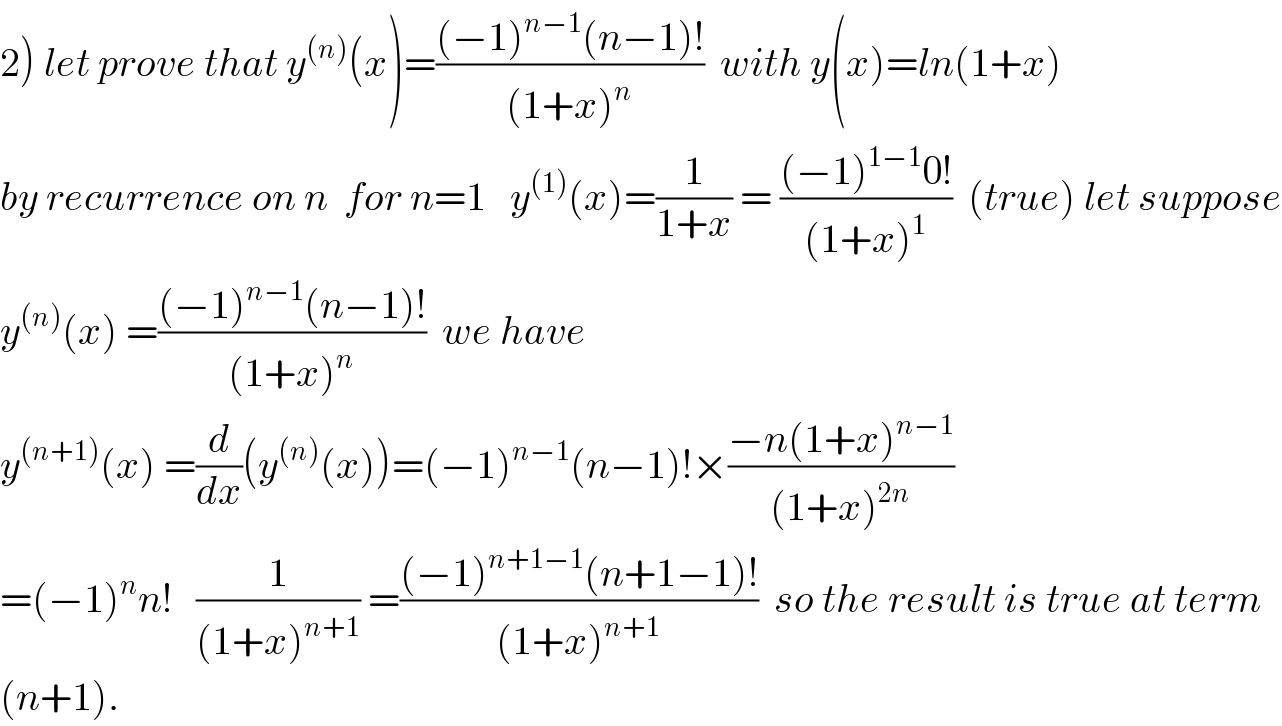
Question and Answers Forum
Question Number 49357 by peter frank last updated on 06/Dec/18

Commented by maxmathsup by imad last updated on 01/Jan/19

Answered by tanmay.chaudhury50@gmail.com last updated on 06/Dec/18
![1)(d^2 x/dt^2 )+k(dx/dt)+n^2 x=pcoswt step1 (d^2 x/dt^2 )+k(dx/dt)+n^2 x=0 let x=e^(αt) so (dx/dt)=αe^(αt) and (d^2 x/dt^2 )=α^2 e^(αt) e^(αt) (α^2 +kα+n^2 )=0 e^(αt) ≠0 α^2 +kα+n^2 =0 α=((−k±(√(k^2 −4n^2 )))/2) Complementary function x=Ae^((((−k+(√(k^2 −4n^2 )))/2))t) +Be^((((−k−(√(k^2 −4n^2 )) )/2))^ t) step 2 determination of particular intregal (d^2 x/dt^2 )+k(dx/dt)+n^2 x=pcoswt let (d/dt)=D and (d^2 /dx^2 )=D^2 so (D^2 +kD+n^2 )x=pcoswt x=(1/(D^2 +n^2 +kD))×pcoswt =(((D^2 +n^2 −kD))/((D^2 +n^2 )^2 −k^2 D^2 ))pcoswt D(pcoswt)=−wpsinwt D^2 (pcoswt)=−w^2 pcoswt =(((−w^2 pcoswt+n^2 pcoswt+kpwsinwt))/((−w^2 +n^2 )^2 −k^2 (−w^2 ))) =p×[(((n^2 −w^2 )coswt+kwsinwt)/((n^2 −w^2 )^2 +k^2 w^2 ))]](Q49403.png)
Answered by tanmay.chaudhury50@gmail.com last updated on 06/Dec/18
![2)y=ln(1+x) (dy/dx)=(1/((1+x))) (d^2 y/dx^2 )=((−1)/((1+x)^2 )) so when n=2 LHS=((−1)/((1+x)^2 )) and RHS=(((−1)^(2−1) (2−1)!)/((1+x)^2 ))=((−1)/((1+x)^2 )) so for n=2 the statement is true now let assume for n=k the statement is true we have to prove that it is true for n=k+1 (d^k y/dx^k )=(((−1)^(k−1) (k−1)!)/((1+x)^k )) so (d/dx)((d^k y/dx^k ))=(d^(k+1) y/dx^(k+1) )←LHS (d/dx)[(((−1)^(k−1) (k−1)!)/((1+x)^k ))] =(((−1)^(k−1) (k−1)!)/1)×(d/dx){(1/((1+x)^k ))} =(−1)^(k−1) (k−1)!×(−k)×(1+x)^(−k−1) =(−1)^(k−1) (k−1)!(−1)k×(1/((1+x)^(k+1) )) =(−1)^(k−1+1) ×k(k−1)!×(1/((1+x)^(k+1) )) =(((−1)^k ×k!)/((1+x)^(k+1) ))←this expression is same if you put n=k+1 in expression (((−1)^(n−1) ×(n−1)!)/((1+x)^n )) hence proved...](Q49404.png)
